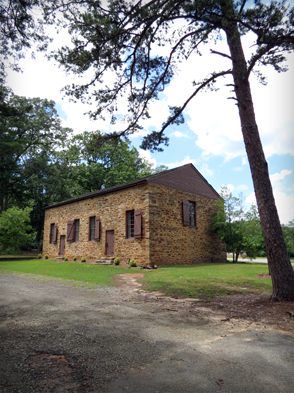 THE OLD CHURCH AND CEMETERY IN THE 20TH AND 21ST CENTURIES:
THE OLD CHURCH AND CEMETERY IN THE 20TH AND 21ST CENTURIES:
The structure and cemetery play as active role in the community. Weddings, funerals, patriotic gatherings, sporadic church services, meetings or lectures, family reunions, and other events mark the yearly calendar.
Remarking graves or having special programs to celebrate the life of a particular person buried in the cemetery is common. John Rusk, the builder of the old Stone Church, and his wife Mary Sterritt were honored in 1936 with new tombstones erected by the State of Texas. This was to recognize the important role that their son, Thomas Jefferson Rusk, played in the history of that state.
A BRIEF HISTORY OF THE CHURCH AND CEMETERY:
A small group of Presbyterians applied to be taken under the care of the South Carolina Presbytery on 13 October 1789. The Hopewell congregation erected a simple log structure near the Seneca/Keowee River for worship in ca. 1791 and remained at that location for several years. A fire purportedly destroyed that structure. Work on a new building made of stone started in 1797 and was completed in 1802.
The Old Stone Church, along with the nearby visitor sites of Pendleton Village, Fort Hill Plantation and Oconee Station, reflect the area’s transition from frontier to antebellum South Carolina society. The church’s early membership constituted a significant percentage of the frontier elite who dominated Pendleton District (now Anderson, Oconee and Pickens counties). Present-day Anderson and Pickens counties are named for individuals buried in the cemetery.
THE CEMETERY:
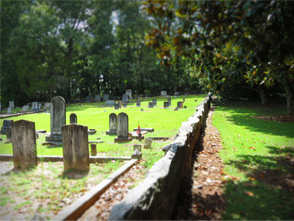 The oldest part of the burial area slightly predates the church. Charles Miller, who died in the fall of 1795, was one of the early burials in the cemetery. Charles was the youngest son of John Miller, who was the first newspaper publisher in the Carolina upcountry and a noted London newspaper publisher during the years of the American Revolution. Located on a corner of John Miller’s land grant, the property would be deeded after 1800 to the congregation.
The oldest part of the burial area slightly predates the church. Charles Miller, who died in the fall of 1795, was one of the early burials in the cemetery. Charles was the youngest son of John Miller, who was the first newspaper publisher in the Carolina upcountry and a noted London newspaper publisher during the years of the American Revolution. Located on a corner of John Miller’s land grant, the property would be deeded after 1800 to the congregation.
Presbyterians associated with the Pendleton area, or with early families entombed there, dominated the oldest parts of the cemetery.During much of the twentieth century, the cemetery served the broader needs of a diverse community often connected with Clemson University.
Although numbers of African-American slaves were members of the congregation, none are buried within the graveyard. Those individuals dying prior to 1865 (and sometimes later) were interred in the slave cemeteries on the various nearby plantations.
THE CHURCH:
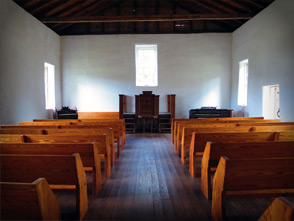 Construction from 1797-1802 by John Rusk (whose descendants would be instrumental in the early years of Texas), the stone structure served the Hopewell Presbyterian congregation for a quarter of a century.Although the building effort commenced near the end of the frontier period (1784-1798) when the threat of Indian attacks was greatly diminished, it is probably that the substantial structure was designed with a defensive component in mind. In the mid-1820s, the congregation moved to Pendleton, which had developed into a gentrified village and was beginning its role in antebellum South Carolina social life.
Construction from 1797-1802 by John Rusk (whose descendants would be instrumental in the early years of Texas), the stone structure served the Hopewell Presbyterian congregation for a quarter of a century.Although the building effort commenced near the end of the frontier period (1784-1798) when the threat of Indian attacks was greatly diminished, it is probably that the substantial structure was designed with a defensive component in mind. In the mid-1820s, the congregation moved to Pendleton, which had developed into a gentrified village and was beginning its role in antebellum South Carolina social life.
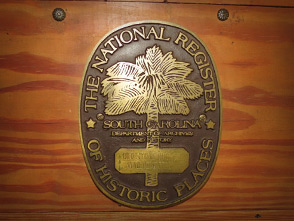 PRESERVATION OF THE OLD STONE CHURCH AND CEMETERY:
PRESERVATION OF THE OLD STONE CHURCH AND CEMETERY:
By the late 1800s, the cemetery grounds were in need of restoration.To promote that goal, descendants of those buried there, as well as other interested persons formed an association. In 1902, the Pendleton Presbyterian Church created a commission to care for the property. Major repairs were made to the building in the second half of the twentieth century.
A FEW OF THE PEOPLE INTERRED HERE:
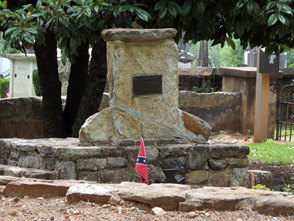 Buried within the cemetery grounds are people involved in the Indian campaigns of the late Colonial Period, soldiers and patriots of the Revolutionary War, the War of 1812, the Indian/Creek War of 1815-16, the Civil War and nearly all American wars thereafter.
Buried within the cemetery grounds are people involved in the Indian campaigns of the late Colonial Period, soldiers and patriots of the Revolutionary War, the War of 1812, the Indian/Creek War of 1815-16, the Civil War and nearly all American wars thereafter.
Osenappa, a Cherokee, occupies on of the oldest graves died ca. 1794. In addition to a marker, a cairn (piled stones) identifies the grave. He is the only Native American buried here. His role in the South Carolina frontier remains undiscovered.
Map #52
General Andrew Pickens, an elder at Old Stone Church, was an Indian fighter and a noted militia leader during the Revolutionary War. He was promoted to the rank of Brigadier General for his role in the Battle of Cowpens.
Following the war, he was a United States commissioner to negotiate treaties with various Indian nations and served as a member of congress. Pickens District (now Pickens and Oconee Counties) was named for him. Tories repeatedly harassed his wife, Rebecca Calhoun Pickens, who is also interred in the cemetery. Map #33A
Colonel Robert Anderson, who served under Andrew Pickens during the Revolution, was a Brigadier General of the state militia following the war, and was a member of the legislature and Lieutenant Governor of South Carolina. He held many other public appointments and served as an elder at the Old Stone Church. Anderson district (now county) was named for him. Map #18A
Jane Lemant Walker was born in Ireland. A teenager during the Revolutionary War, she served as a courier for General Thomas Sumter.Walker, a seamstress, carried messages in her double-heeled stockings. William Walker, her husband, is buried beside her. These graves are marked by the DAR as Patriots. Map #8
Reverend Dr. Thomas Reece* and Reverend James McElhenny^ represent the early Presbyterian ministers who served the Hopewell Congregation. *Map #12, ^Map #53
Turner Bynam, the loser in a famous antebellum duel between newspaper editors was denied burial within the graveyard—being allowed instead to rest outside the walls. The historic intent of some church elders has not always survived to the present. With the expansion of the cemetery over the years, he is now near the center.
Eliza Huger, according to a long told story was a member of a prominent Charleston family who moved to New Orleans. Even by the standards of that city, her actions were considered scandalous. The story tells that Eliza’s brother shot her and her lover. Burial within the cemetery was allowed only on the condition that as enclosure be constructed around the site. Her grave lies within a high stonewalls and reads “A BROTHER’S SORROW”. Map #54
Civil War Soldiers: The graves of Forty-five soldiers have been marked with Iron Crosses. Several members of the Lewis family werein battles at Fredericksburg and Manassas. They are buried together under a unique mini-ball marker.
Revolutionary War: There are 13 Patriots of the Revolutionary War marked by the DAR and SAR. Two are women, Jane Lamant Walker and Rebecca Calhoun Pickens.
Early Presidents of Old Stone Church and Cemetery Commission: Mark Bernard Hardin and Richard Brackett both heads of the Chemistry Department at Clemson College (now Clemson University). Hardin was a major of Artillery in the volunteer forces of Virginia during the early 1860s. He witnessed the battle between the Merrimac and the Monitor in 1862. Richard Newman Brackett succeeded Harden. Dr. Brackett worked to preserve the history of the cemetery and the church building during the early 1900s.

